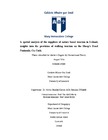| dc.description.abstract | The tourism industry from 2012 to 2022 is expected to grow by an average of 4% annually
to constitute 10% of global GDP (US$10 trillion). It is also predicted by 2022, globally,
one in every ten jobs (328 million) will be tourism-related. With the unprecedented growth
of tourism it is essential that sustainable planning guidelines are adhered to. Sustainable
management of our natural resources is now a high priority, as tourism planners attempt to
avoid past problems associated with the mass tourism market as happened in the case of the
rapid growth of the Costas around the Mediterranean Sea from the 1960s until the 1990s.
This type of mass or ‘fast tourism’ represents the very antithesis of a type of tourism that is
considered sustainable. The dominant approaches to tourism development heretofore
illustrated little or no concern for the existing landscape, social, environmental or economic
and it is hoped that the dawn of ‘slow tourism’ and more ecological approaches that are
based on a valorisation of natural landscapes can avoid, and to some extent, ameliorate the
problems of the past and rejuvenate rural economies.
This thesis looks in detail at an example of a tourism product that is based on the principles
and practices of sustainability, as it examines the walking tourism industry in the Sheep’s
Head Way on the south-west coast of Ireland as a mechanism for local development. The
primary data and information gathered form a narrative of the innovative efforts that led to
the development of the walkway. A near census of the peninsula provides an in-depth
analysis of landowners’ and farmers’ attitudes to the evolution of the walkway as well as
other attributes such as: environmental awareness, issues of sustainability, community
links, farm diversification and conservation of the landscape. The success of the walkway
is achieved through effective collaboration, financial assistance from REPS (Rural
Environmental Protection Scheme), Walks Scheme payments, and the desire of a
community to showcase their native and spectacular landscape. The results illustrate
significant differences among the landowners' orientations towards the environment and a
range of factors that influence landowners' intentions to engage in environmental
conservation and sustainable tourism. Other themes that emerge through this study include
local economic benefits, community collaboration and land access rights. Suppliers of
nature-based tourism activities are at the helm of the future direction of sustainable tourism
vi
and it is essential that they are consulted and surveyed with the same detail as users of
nature-based activities. | en |


